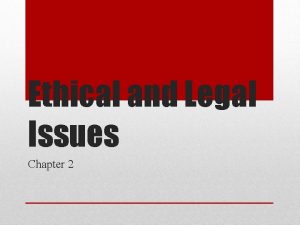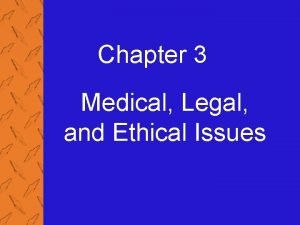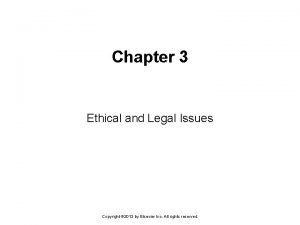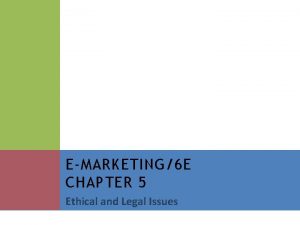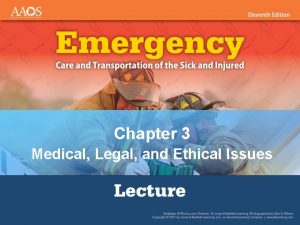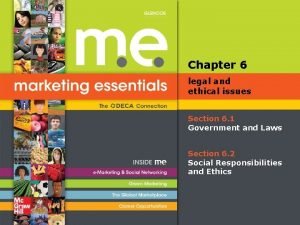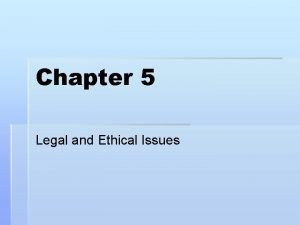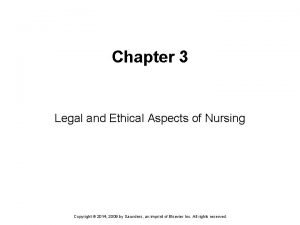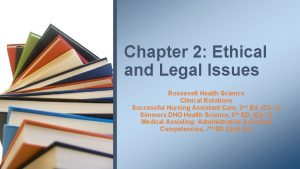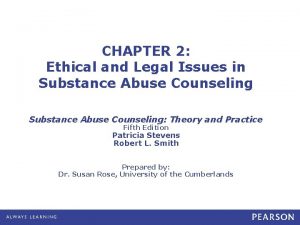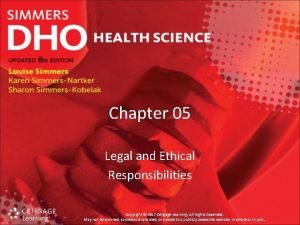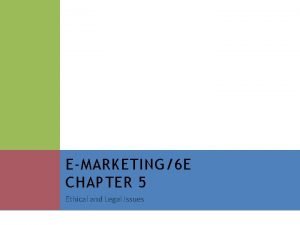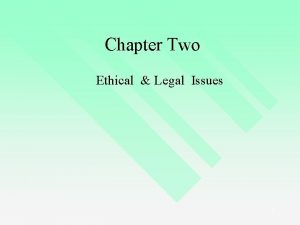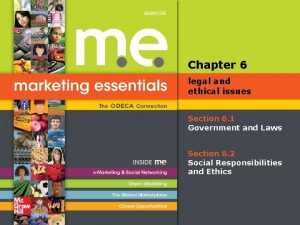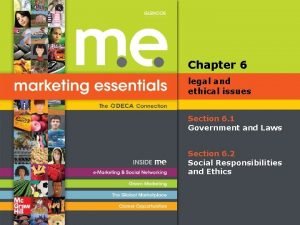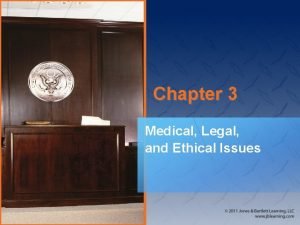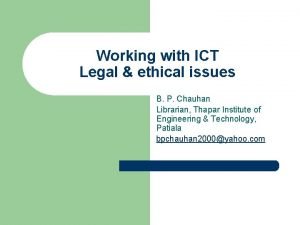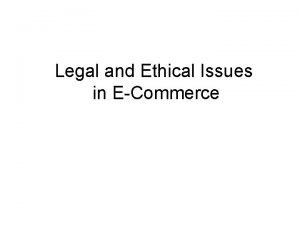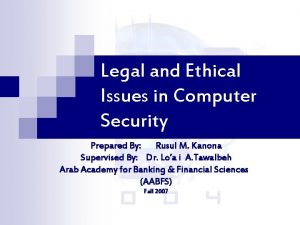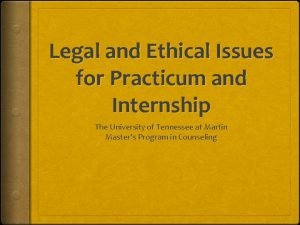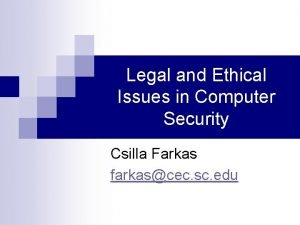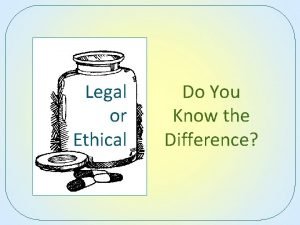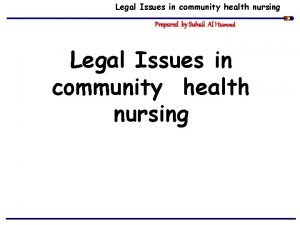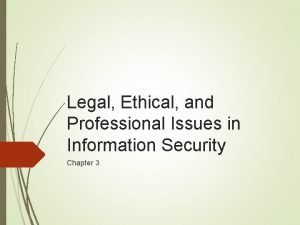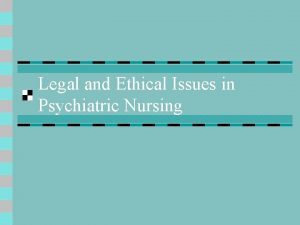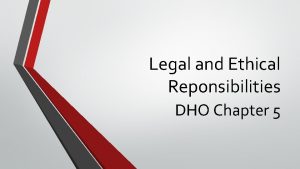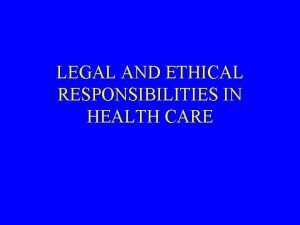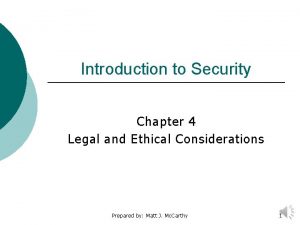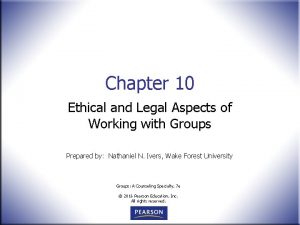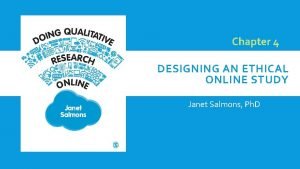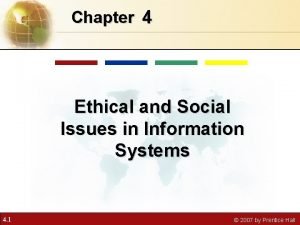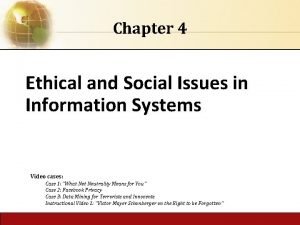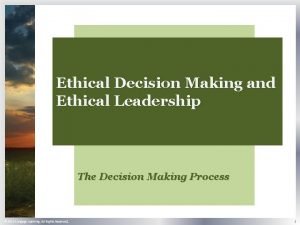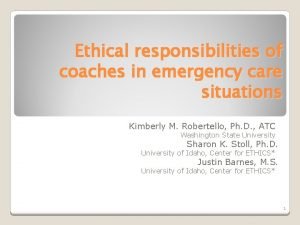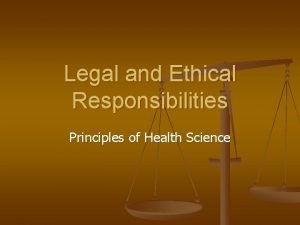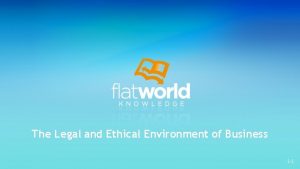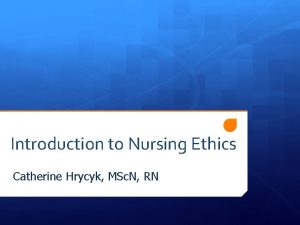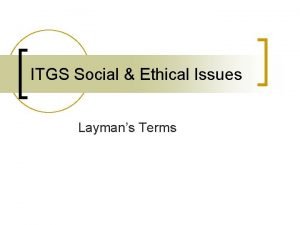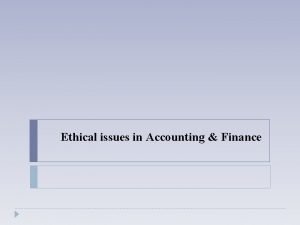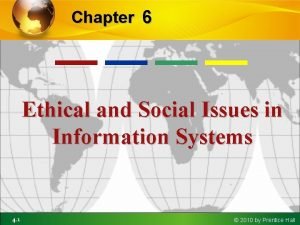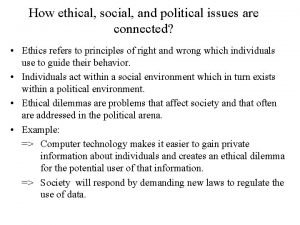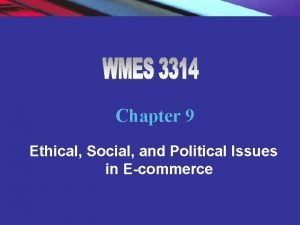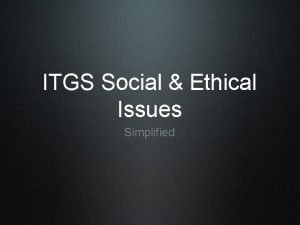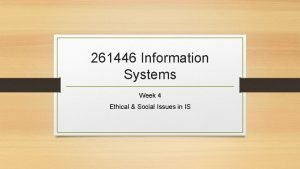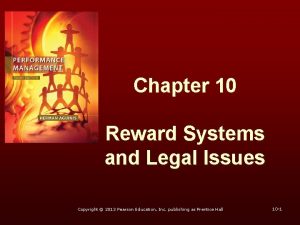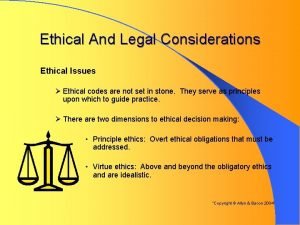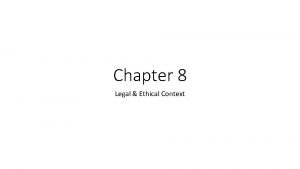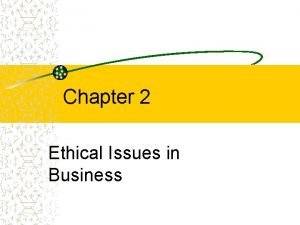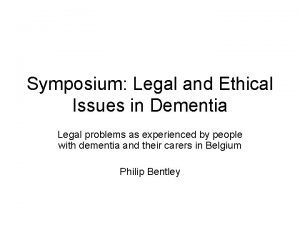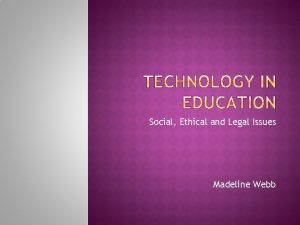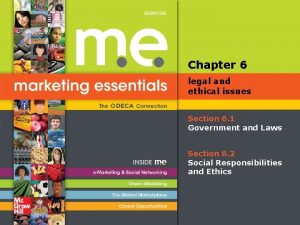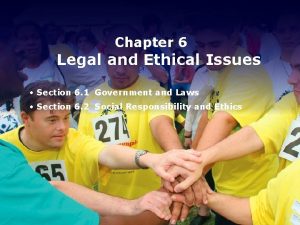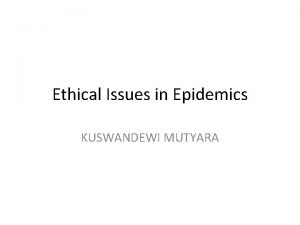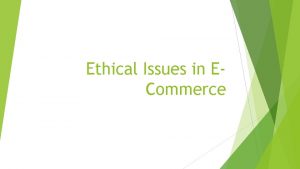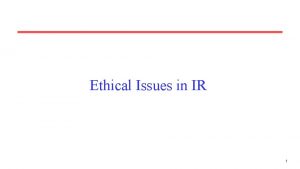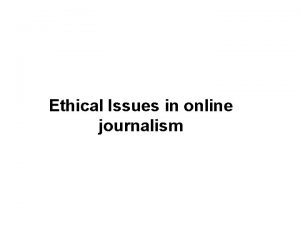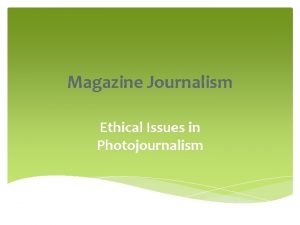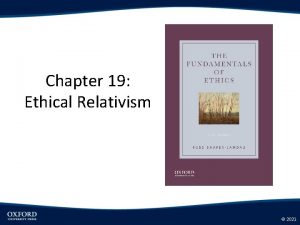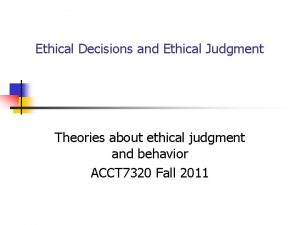Chapter 6 legal and ethical issues Section 6


















































- Slides: 50

Chapter 6 legal and ethical issues Section 6. 1 Government and Laws Section 6. 2 Social Responsibilities and Ethics

Section 6. 1 Government and Laws DISCUSS What effect does the government have on your life?

Section 6. 1 Government and Laws Explain the role of government in the private enterprise system. Identify federal regulatory agencies and laws that protect consumers, workers, investors, and the environment. Provide examples of the impact of government on business.

Section 6. 1 Government and Laws In the U. S. private enterprise system, the government plays a role in safeguarding its principles and the welfare of its citizens.

Section 6. 1 Government and Laws Food and Drug Administration (FDA) Consumer Product Safety Commission (CPSC) Equal Employment Opportunity Commission (EEOC) Occupational Safety and Health Administration (OSHA) Securities and Exchange Commission (SEC) Environmental Protection Agency (EPA) Federal Trade Commission (FTC)

Section 6. 1 Government and Laws The U. S. Government and Its Role in the Private Enterprise System

Section 6. 1 Government and Laws The U. S. Government and Its Role in the Private Enterprise System

Section 6. 1 Government and Laws The Role of Government The Government Provider of Services Customer Enforcer of Private (Free) Enterprise Regulator Monitor of the Economy

Section 6. 1 Government and Laws The Role of Government The Government Executive Branch Legislative Branch Judicial Branch

Section 6. 1 Government and Laws The Role of Government The Primary Duty of Each Branch of Government

Section 6. 1 Government and Laws The Role of Government The Primary Duty of Each Branch of Government

Section 6. 1 Government and Laws The Role of Government Products Federal Agencies Regulate Employees Environment Businesses

Section 6. 1 Government and Laws The Role of Government The Role of Regulator Protecting Consumers Protecting Workers Protecting Investors Food and Drug Administration (FDA) Consumer Product Safety Commission (CPSC) Food and Drug Administration (FDA) Regulates the labeling and safety of food, drugs, and cosmetics sold throughout the United States. Consumer Product Safety Commission (CPSC) Responsible for overseeing the safety of products such as toys, electronics, and household furniture. Protecting the Environment

Section 6. 1 Government and Laws The Role of Government The Role of Regulator Protecting Consumers Food and Drug Administration (FDA) Consumer Product Safety Commission (CPSC) Protecting Workers Protecting Investors Equal Employment Opportunity Commission (EEOC) Occupational Safety and Health Administration (OSHA) Equal Employment Opportunity Commission (EEOC) Responsible for the fair and equitable treatment of employees with regard to hiring, firing, and promotions. Occupational Safety and Health Administration (OSHA) Sets guidelines for workplace safety and environmental concerns and enforces those regulations. Protecting the Environment

Section 6. 1 Government and Laws The Role of Government The Role of Regulator Protecting Consumers Food and Drug Administration (FDA) Consumer Product Safety Commission (CPSC) Protecting Workers Equal Employment Opportunity Commission (EEOC) Protecting Investors Protecting the Environment Securities and Exchange Commission (SEC) Occupational Safety and Health Administration (OSHA) Securities and Exchange Commission (SEC) Regulator of the sale of securities (stocks and bonds). It is responsible for issuing licenses to brokerage firms and financial advisers and investigates any actions among corporations that affect the value of stocks.

Section 6. 1 Government and Laws The Role of Government The Role of Regulator Protecting Consumers Food and Drug Administration (FDA) Consumer Product Safety Commission (CPSC) Protecting Workers Equal Employment Opportunity Commission (EEOC) Protecting Investors Securities and Exchange Commission (SEC) Protecting the Environmental Protection Agency (EPA) Occupational Safety and Health Administration (OSHA) Environmental Protection Agency (EPA) Protects human health and our environment. Its responsibilities include monitoring and reducing air and water pollution and overseeing recycling and hazardous waste disposal.

Section 6. 1 Government and Laws The Role of Government Enforcer of the Private Enterprise System Federal Trade Commission (FTC) Bureau of Consumer Protection Bureau of Competition Federal Trade Commission (FTC) Enforces the principles of a private enterprise system and protects consumers from unfair or deceptive business practices. Bureau of Economics

Section 6. 1 Government and Laws The Role of Government Differences and Similarities

Section 6. 1 Government and Laws The Role of Government Differences and Similarities

Section 6. 1 Government and Laws The Role of Government Bureau of Consumer Protection

Section 6. 1 Government and Laws The Role of Government Bureau of Consumer Protection

Section 6. 1 Government and Laws The Role of Government Bureau of Consumer Protection

Section 6. 1 Government and Laws The Role of Government Bureau of Consumer Protection

Section 6. 1 Government and Laws The Role of Government The SEC

Section 6. 1 Government and Laws The Role of Government The SEC

Section 6. 1 Government and Laws Section 6. 1 1. Identify five roles the government plays in a private enterprise system. The five roles the government plays in a free enterprise system are provider of services, customer, regulator, supporter of private (free) enterprise, and monitor of the economy.

Section 6. 1 Government and Laws Section 6. 1 2. Compare and contrast the roles of the three bureaus run by the Federal Trade Commission. All three are concerned with enforcing the principles of the private enterprise system and protecting consumers, but the ways in which they accomplish this differ. The Bureau of Consumer Protection is responsible for protecting consumers from businesses that violate laws and regulations; the Bureau of Competition is responsible for preventing anti-competitive mergers and business practices; the Bureau of Economics studies the impact of FTC actions on consumers.

Section 6. 1 Government and Laws Section 6. 1 3. Describe how antitrust laws promote healthy competition in a private enterprise system. Because these laws are designed to prevent anti-competitive mergers and business practices, they make certain that goods and services are priced competitively.

Section 6. 2 Social Responsibilities and Ethics JUDGE Why do you think it is a good idea for companies to be socially responsible?

Section 6. 2 Social Responsibilities and Ethics Provide examples of a business’s social responsibilities. Explain the concept of business ethics. Apply guidelines for ethical behavior.

Section 6. 2 Social Responsibilities and Ethics Socially responsible and civic-minded businesses are concerned with their workers, customers, communities, and the environment. Business ethics are part of social responsibility and play a role in decisions made by businesses.

Section 6. 2 Social Responsibilities and Ethics flextime ethics telecommunicating Better Business Bureau Ad Council price gouging green marketing whistle blowing

Section 6. 2 Social Responsibilities and Ethics Information on Social Responsibility, Ethics in Business, and the Guidelines for Ethical Behavior

Section 6. 2 Social Responsibilities and Ethics Information on Social Responsibility, Ethics in Business, and the Guidelines for Ethical Behavior

Section 6. 2 Social Responsibilities and Ethics Business and Social Responsibility In the Workplace Flextime flextime A system that allows workers to choose their work hours. Telecommuting Extended Family Leave On-Site Child Care Health Care Benefits Time Off with Pay telecommuting Working at home, usually on a computer. Employees can send completed tasks by e-mail or mail-in disk.

Section 6. 2 Social Responsibilities and Ethics Business and Social Responsibility In the Marketplace Providing Information – The Ad Council Employing Self-Censorship Responding to Consumer Concerns Ad Council A nonprofit organization that helps produce public service advertising campaigns for government agencies and other qualifying groups.

Section 6. 2 Social Responsibilities and Ethics Business and Social Responsibility In the Community Supporting Community Causes World Business Council for Sustainable Development (WBCSD)

Section 6. 2 Social Responsibilities and Ethics Business and Social Responsibility In the Environment Alternative Fuels Green Marketing green marketing When companies engage in the production and promotion of environmentally safe products.

Section 6. 2 Social Responsibilities and Ethics Business and Social Responsibility The Uses of Employee Benefits

Section 6. 2 Social Responsibilities and Ethics Business and Social Responsibility The Uses of Employee Benefits

Section 6. 2 Social Responsibilities and Ethics Business Ethics A major aspect of social responsibilities is business ethics Guidelines for good behavior; the basic values and moral principles that guide the behavior of individuals and groups.

Section 6. 2 Social Responsibilities and Ethics Business Ethics Consumers Have Four Basic Rights According to John F. Kennedy’s Consumer Bill of Rights To be informed and protected against fraud, deceit, and misleading statements, and to be educated in the wise use of financial resources. To be protected from unsafe products. To have a choice of goods and services. To have a voice in product and marketing decisions made by government and businesses.

Section 6. 2 Social Responsibilities and Ethics Business Ethics in Marketing Self-Regulation – Better Business Bureau (BBB) Marketing Functions – Price Gouging Marketing Information Selling Practices Better Business Bureau (BBB) Nonprofit organization that sets up self-regulation among businesses. Business members must “agree to follow the highest principles of business ethics and voluntary selfregulation, and have a proven record of marketplace honesty and integrity. ” price gouging Pricing products unreasonably high when the need is great or when consumers do not have other choices.

Section 6. 2 Social Responsibilities and Ethics Business Ethics

Section 6. 2 Social Responsibilities and Ethics Business Ethics

Section 6. 2 Social Responsibilities and Ethics Business Ethics Managerial and Personnel Issues Proper Accounting and Reporting – The Sarbanes-Oxley Act of 2002 Whistle Blowing whistle blowing Reporting an illegal action of one’s employer.

Section 6. 2 Social Responsibilities and Ethics Section 6. 2 1. Explain Why are employee benefits that demonstrate social responsibility helpful for businesses and their employees? These benefits simplify employees’ lives and aid them in times of difficulty, so they increase the chances that employees will remain at a job. They are helpful to businesses because they have less employee turnover. The businesses’ reputations are improved because they are seen as being concerned with the welfare of their workers.

Section 6. 2 Social Responsibilities and Ethics Section 6. 2 2. Describe how businesses demonstrate social responsibility in the marketplace and in the community. In the marketplace, businesses provide information, employ selfcensorship, and respond to consumer concerns. In the community, businesses support community efforts (e. g. , sponsor sports teams, food drives, and so on), contribute money to worthy causes, and promote sustainable development.

Section 6. 2 Social Responsibilities and Ethics Section 6. 2 3. Define business ethics. Business ethics are guidelines for good behavior. Ethical businesses are honest and fair with everyone–workers, consumers, and the communities in which they operate.

End of Chapter 6 legal and ethical issues Section 6. 1 Government and Laws Section 6. 2 Social Responsibilities and Ethics
 Ethical and legal issues chapter 2
Ethical and legal issues chapter 2 Medical legal and ethical issues chapter 3
Medical legal and ethical issues chapter 3 Legal and ethical issues chapter 3
Legal and ethical issues chapter 3 Legal and ethical issues chapter 5
Legal and ethical issues chapter 5 Medical legal and ethical issues chapter 3
Medical legal and ethical issues chapter 3 Chapter 6 legal and ethical issues
Chapter 6 legal and ethical issues Chapter 5 legal and ethical issues
Chapter 5 legal and ethical issues Legal and ethical aspects in nursing
Legal and ethical aspects in nursing Chapter 2 ethical and legal issues
Chapter 2 ethical and legal issues Ethical and legal issues chapter 2
Ethical and legal issues chapter 2 Ch 5 legal and ethical responsibilities
Ch 5 legal and ethical responsibilities Legal and ethical issues chapter 5
Legal and ethical issues chapter 5 Chapter 2 ethical and legal issues
Chapter 2 ethical and legal issues Chapter 6 legal and ethical issues
Chapter 6 legal and ethical issues Chapter 6 legal and ethical issues
Chapter 6 legal and ethical issues Chapter 3 legal and ethical issues
Chapter 3 legal and ethical issues Ethical media issues
Ethical media issues State legal, ethical and professional aspects of security.
State legal, ethical and professional aspects of security. Legal and ethical issues in use of ict in education
Legal and ethical issues in use of ict in education Legal ethical and taxation issues in e business
Legal ethical and taxation issues in e business Legal and ethical issues in computer security
Legal and ethical issues in computer security Ethical and legal issues involved in practicum
Ethical and legal issues involved in practicum Legal and ethical issues in computer security
Legal and ethical issues in computer security Ethical and legal issues affecting the nursing assistant
Ethical and legal issues affecting the nursing assistant What is the difference between ethical and legal issues
What is the difference between ethical and legal issues Legal issues in community health nursing
Legal issues in community health nursing Legal and ethical issues in information security
Legal and ethical issues in information security Ethical and legal issues in psychiatric nursing
Ethical and legal issues in psychiatric nursing Dho chapter 5 legal and ethical responsibilities
Dho chapter 5 legal and ethical responsibilities Chapter 5 legal and ethical responsibilities answer key
Chapter 5 legal and ethical responsibilities answer key Chapter 4 legal and ethical responsibilities
Chapter 4 legal and ethical responsibilities Nonmaleficence
Nonmaleficence Chapter 4 ethical issues
Chapter 4 ethical issues 4 components of an information system
4 components of an information system Ethical issues in qualitative research chapter 4
Ethical issues in qualitative research chapter 4 Chapter 4 ethical issues
Chapter 4 ethical issues Chapter 4 ethical issues
Chapter 4 ethical issues The perceived relevance or importance of an ethical issue
The perceived relevance or importance of an ethical issue Legal and ethical responsibilities of a coach
Legal and ethical responsibilities of a coach Legal and ethical principles in healthcare
Legal and ethical principles in healthcare Legal and ethical environment of business
Legal and ethical environment of business Ethical and legal frameworks in nursing
Ethical and legal frameworks in nursing Social ethical issues itgs
Social ethical issues itgs Accounting ethical issues
Accounting ethical issues Key technology trends that raise ethical issues
Key technology trends that raise ethical issues Ethical and social issues in information systems doc
Ethical and social issues in information systems doc How ethical social and political issues are connected
How ethical social and political issues are connected Ethical social and political issues in e-commerce
Ethical social and political issues in e-commerce Itgs social and ethical issues
Itgs social and ethical issues Ethical and social issues in information systems
Ethical and social issues in information systems Reward system and legal issues
Reward system and legal issues
